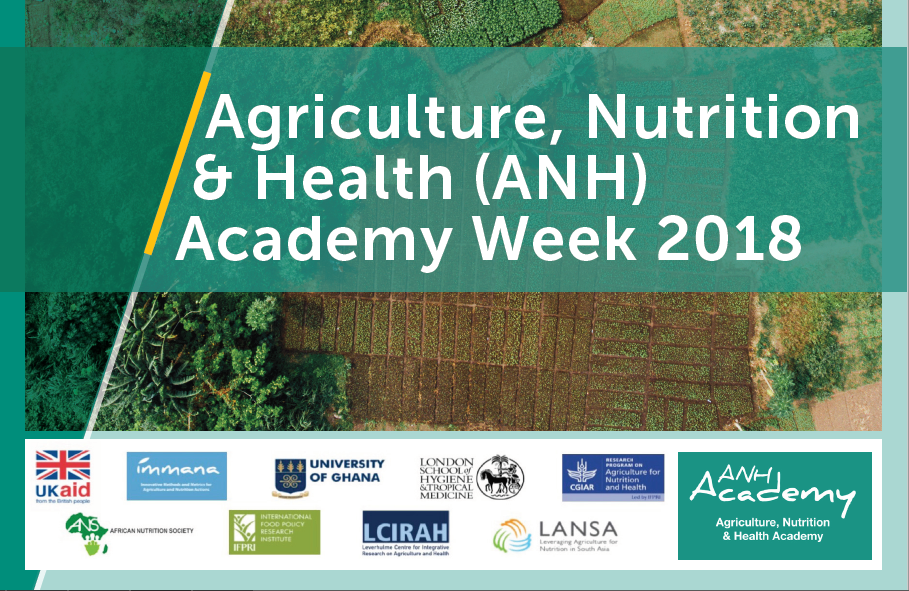
Six sub-sessions
Chair: Edward Frongillo, University of South Carolina
Speakers and presentations
Pilar Useche | Diana Carolina Lopera, CIAT
Do Gendered Food Choices and Time Allocation Preferences Influence the Nutrition of Agricultural Households?
Recording
Anna Herforth, Tufts University
The Cost of Nutritious Diets in Africa and South Asia: New Insights from Food Price Data
Recording
Jasmine Kelly, Emory University Rollins School of Public Health
“Eating Down” Amongst Rural Tanzanian Women: Examining the Association between Socio-Cultural Beliefs and Diets in Pregnancy
Recording
Hibbah Araba Osei-Kwasi, University of Sheffield
Factors Associated with Dietary Behaviours in Urban Africa from Adolescence to Adulthood - Extending the Reach of a Systematic Mapping Review: A TACLED Study
Recording
Amy Webb Girard, Emory University
Understanding the Drivers of Diet Change and Food Choice among Tanzanian Pastoralists
Recording
Frances Knight, LSHTM
Food-Based Recommendations Can Be Formulated in Optifood, for Rural 12–23-Month-Old Children in Low- and Middle-Income Countries, Using Household Consumption and Expenditure Survey Data Instead of 24-Hour Recall Data, Allowing for Rap
Slides / Recording
Q&A
Recording
Do Gendered Food Choices and Time Allocation Preferences Influence the Nutrition of Agricultural Households?
Pilar Useche | Diana Carolina Lopera, CIAT
Introduction
Observing how food choices of rural family members change when receiving cash and nutrition information, as well as how they allocate their time (out of the home or at home), is key to understanding measures to improve their nutrition. However, these choices are difficult to observe. For example, a household member may recall general household food consumption, but not each person’s share. Therefore, it is unknown how increases in income, or new information about nutrition, may change family allocations of time and food, which in turn influence nutritional status. In particular, it is unknown if these changes vary by gender.
Methods
We design and implement choice experiments to measure how food and time allocation decisions vary with income and information. We examine differences among men and women within the household and relate these to household nutrition. Important features of our experiments are: 1) For replicability by researchers and program implementers in rural areas of developing countries, we implemented choice experiments instead of randomized control trials, which are very expensive, 2) To prevent hypothetical biases we provided a voucher with a real money value, to be exchanged for food in a local store, 3) Accounted for heterogeneous preferences of men and women within the household, and 4) Allowed for interaction between household members to capture intra-household dynamics.
We implemented these experiments in two regions of Guatemala, one with strong indigenous influence (West), and one with more white and mestizo inhabitants (East). Information was elicited from 250 households through three different types of instruments: a household questionnaire, an individual questionnaire, and the choice experiments. We elicited information from couple-headed households only. The experimental games involved having each couple make decisions, first, separately, and then jointly; and with three different budget levels. One of the budget-choice combinations involved the real purchase of food and products.
Findings and Interpretations
We are still finalizing our data analysis, yet preliminary findings show that individuals that receive additional income still choose low levels of food diversity, preferring high amounts of staples and expensive foods (like meat). In the East, women tended to prioritize food quantity more than men. One potential reason being that women often did not have the opportunity to purchase foods on a frequent basis. Generally, men had more mobility and went to the larger market to purchase food on trips where they also addressed other businesses. Indeed, the working roles and preferences that men and women have in a household are tightly related to the roles they play along the chain of food access-choice-consumption. Experiments measuring labor preferences show that, in spite of being traditional communities, there is a large heterogeneity in the preferences of men and women for agricultural versus home cooking and cleaning work, and many men would be willing to dedicate more hours to the home if they received enough benefits. Additional findings are that indigenous households appear to have more rigid food preferences, with less variety in their choices, and the least healthy food choices were mostly selected by households with young children.
Conclusions
Preliminary results show the relevance of considering gender roles and intra-household work dynamics in designing nutritional interventions. Both men and women’s decisions play a significant role in the chain of events that determine household resource allocation to nutrition and hygiene, yet roles vary across communities and households. In fact, they are dynamic, and in many households, flexible. Thus, nutritional interventions should not only target women because they are traditionally seen as the ones making food-related decisions, but also should provide incentives to the men who are willing to contribute to home production activities. This is particularly important in areas (like Eastern Guatemala), where women allocate a higher share of their time to labor outside the home. Men also play an important role in the choice, type, and diversity of food due to their higher mobility and market access.
The Cost of Nutritious Diets in Africa and South Asia: New Insights from Food Price Data
Anna Herforth, Tufts University
Introduction
Access to adequate food for all is a cornerstone of the development agenda. Agriculture has an essential role toward increased availability and affordability of nutritious food, but information is lacking to inform effective actions. Food price monitoring typically prioritizes foods based on economic importance and omits nutritional adequacy. Existing data, however, can be harnessed to understand the cost of nutritious diets, and to compare costs across seasons and regions.
Methods
Using the same food price data that national agencies routinely collect, we calculate the price of nutritious diets in Ghana, Tanzania, Afghanistan, India, Pakistan, and Sri Lanka. We apply three methods to account for nutrition in the price of food: the Cost of a Recommended Diet (CoRD), the Cost of Nutrient Adequacy (CoNA), and the Nutritious Food Price Index (NPI). CoRD shows the minimum cost of meeting food-based dietary guidelines, which represent diets that are intended to meet nutrient needs and protect health in the long term. CoNA, a metric based on linear programming, models the minimum cost of achieving nutrient adequacy, and compares this to the cost of caloric adequacy. The NPI is an index that shows the price of nutrient-dense foods relative to the price of foods typically purchased.
These methods, first developed in the IANDA project (Indicators of Affordability of Nutritious Diets in Africa) under an IMMANA grant, have been applied to gain new insights into seasonality and within-country regional variation in South Asia through the South Asia Food and Nutrition Security Initiative (SAFANSI) managed by the World Bank, and in Africa through the CANDASA project (Changing Access to Nutritious Diets in Africa and South Asia).
Findings and Interpretations
We find that the cost of recommended diets is higher than the cost of nutrient adequacy; both are higher than the cost of caloric adequacy, and more seasonally variable. In Ghana, a nutritionally weighted food basket is more expensive in some regions than others, relative to the typical food basket. In Tanzania, seasonality in the price of food is larger in more remote locations such as the far west (Kigoma) and north (Kilimanjaro), but also in southern “breadbasket” areas such as Iringa and Ruvuma.
In South Asia, CoRD highly varies across cities, largely due to the variation in the cost of vegetables. Using the NPI, we further find that compared to a typical food basket, the price of a nutritious food basket is more subject to seasonality, and for Pakistan and India it has been increasing faster over time. While the prices of the most energy-dense foods (cereals, oils and fats, sugars) are the most stable, the prices of the most nutrient-dense foods are increasing faster and are more variable. The pronounced seasonality and faster increase seem driven by vegetable prices.
Conclusions
We find that the price of the most nutrient-dense foods is generally rising faster, and is more seasonally and regionally variable, than the price of energy-dense, low-micronutrient foods. In particular, vegetable prices drive pronounced seasonality and inflation in the cost of nutritious diets in South Asia. The energy-dense foods generally have a longer shelf-life for storage and transportation than the most nutrient-dense foods, which tend to be highly perishable. Food security and agriculture policies have historically emphasized energy-dense foods. Increased attention in the agricultural sector to the most nutrient-rich foods may be needed to improve year-round access to adequate food. In particular, actions to reduce prices and seasonality of vegetables, and to better integrate markets for vegetables and other perishable, nutrient-dense foods, can reduce the cost and price volatility of nutritious diets.
“Eating Down” Amongst Rural Tanzanian Women: Examining the Association between Socio-Cultural Beliefs and Diets in Pregnancy
Jasmine Kelly, Emory University Rollins School of Public Health
Introduction
Inadequate nutrition during pregnancy is a known risk factor for poor birth outcomes globally. While several factors can cause inadequate diets and nutrition in low socio-economic contexts, including lack of income and environmental constraints, research suggests socio-cultural beliefs may also contribute. “Eating down,” reducing food intake during pregnancy due to socio-cultural pregnancy-related beliefs, is documented as contributing to inadequate maternal nutrition throughout many cultures. Using community perspectives, we examine this phenomenon through 1) experiences of facing pressure to comply with diet practices, 2) perceived negative consequences of eating ‘too much,’ and 3) beliefs that certain foods can cause birth complications.
Methods
From February to October 2017, qualitative data were collected in two phases from six rural towns in the Handeni and Tanga districts of Tanzania. Sites were purposively selected to include extensive pastoral, extensive sedentary and intensive sedentary communities. Each phase included three primary data collection methods (i.e. in-depth interviews (IDI), key informant interviews (KII), and focus group discussions (FGD)). Using a grounded theory approach, Phase I preliminary results were analyzed and used to inform objectives for Phase II. IDIs and KIIs were administered to eligible and consenting residents of each town. FGDs were conducted with each of the six respondent categories: female and male youth (16-30 years old), women and men of reproductive age (31-64 years old), and female and male elders (>65 years old). Ethnic groups interviewed included Zigua, Maasai, and Pare.
All qualitative data was collected in Kiswahili or the local language and transcribed/translated by multilingual Tanzanian research team members. Transcriptions were coded using MaxQDA and analyzed for major themes and patterns using a combination of thick description and theory development.
Findings and Interpretations
Participants included members of the Zigua, Maasai, Pare, Gogo, and Mburu groups and ranged from 16 to 80 years old. The majority of respondents, 52 percent (n=104), had no schooling, with 29.44 percent (n=58) completing primary school and 12.18 percent (n=24) completing secondary school. Preliminary analysis suggests that women in these communities commonly reduce food consumption and avoid specific foods during pregnancy. Foods were reduced or avoided to prevent weight gain by the mother, weight gain by the fetus, disruption of the umbilical cord, difficult delivery, and complicated deliveries. Overall, the most commonly avoided foods cited by participants were eggs, milk, and meat; these foods were perceived to contribute the most to fetal growth. Eating down and food avoidance were most commonly mentioned amongst the Maasai, though other groups also mentioned practicing these restrictions. Foods, such as eggs, fish, and cold foods, were also avoided by pregnant women because they caused nausea and vomiting. Despite food reductions and avoidance, preliminary results also suggest that some pregnant women are prioritized for specific special foods, depending on their ethnic group. These foods are believed to promote stimulation and proper functioning of the body and included sheep fat, animal blood, ugali, and Irish potatoes.
Conclusions
Eating down and specific food restrictions are common in this rural Tanzanian setting. Despite the eating down phenomenon, other high-quality foods are promoted for pregnant women. These findings have implications for the design of culturally sensitive programs aimed at improving maternal diets in pregnancy. This study was specific to pastoral and cattle-keeping communities and thus may not be applicable to other subsistence agriculture communities. Exploration of these issues in other ethnic groups and agro-ecological zones will be needed to better understand these practices in Tanzania and make culturally appropriate food-based recommendations for pregnancy nutrition.
Factors Associated with Dietary Behaviours in Urban Africa from Adolescence to Adulthood - Extending the Reach of a Systematic Mapping Review: A TACLED Study
Hibbah Araba Osei-Kwasi, University of Sheffield
Introduction
Dietary patterns within Africa are changing. The nutrition transition describes the way in which diets in low- and middle-income countries are shifting away from traditional diets and eating habits in rapidly urbanising environments. Available evidence links the increasing prevalence of obesity to the nutrition transition. This systematic review mapped the factors associated with dietary behaviours among adolescents and adults living in urban Africa and identified priority areas for future research.
Methods
A systematic mapping review was conducted to extend and update an existing review of drivers of food choice of women living in urban Africa, which was undertaken in 2015. Aside from women, the current review included adolescents (11-17 years of age) and men. A protocol was defined and registered on the PROSPERO database (registration number CRD4201706893). Electronic searches across MEDLINE, EMBASE, PsycInfo, CINAHL, African Index Medicus and ASSIA were conducted alongside citation tracking (forward and backward citation tracking) using Google Scholar (through Publish or Perish™). Quality appraisal occurred in parallel with data extraction. Factors were compiled into a map adapted from an existing socio-ecological model based on research in high-income countries. Findings were synthesised narratively.
Findings and Interpretations
Thirty-eight studies were included in the final mixed-methods data synthesis. Populations included 12 studies of adolescents, 11 of adult females and 14 mixed adult studies. In total 65, 47 and 42 factors were identified for adult women, adult men and adolescents respectively. Significant associations were found between dietary behaviors and socio-economic status. Stress levels were found to be significantly associated with unhealthy dietary behaviours in a mixed adult population with the effect being more pronounced in men. Biological level factors found to be significantly associated with dietary behaviour in adults were morbidity, age and parity. Factors specific to the adolescents were self-esteem, body satisfaction, ideal body size, dieting, school registration, gender, body composition, pubertal development, BMI, and fat mass. However only age, BMI, and fat mass were found to be significantly associated with dietary behaviors. There were more social-level factors (e.g., friendship) identified in adolescents compared to the adults. The role of religious groups on dietary behaviors was investigated in one study, however, religious groups cannot be accommodated within the existing sub-levels defined by Story et al. (2008). Macro-level factors were neglected by all groups with only four factors identified.
Conclusions
In all population groups studied, the individual and household domains of the socio-ecological model were the most represented by included studies. This may indicate that by targeting cognitions, skills and behaviors, lifestyle, biological and socio-economic factors, the general population of urban Africa may benefit. The dominance of studies exploring individual-level factors however, suggests a need for research to explore the social, physical and macro-level environments. By understanding factors influencing dietary behaviors within separate population groups, specific targeted interventions can be developed to combat nutrition-related non-communicable diseases in urban Africa. The evidence from this review will contribute towards developing a conceptual framework for the study of factors influencing dietary behaviours in urban Africa.
Understanding the Drivers of Diet Change and Food Choice among Tanzanian Pastoralists
Amy Webb Girard, Emory University
Introduction
Pastoralists represent more than 300-600 million people globally. In response to increasing environmental, social, and political pressures, pastoral communities are shifting to more sedentary livelihood strategies (sedentarization) - a process shown to adversely impact both maternal and child nutrition. To explore contributors to diet change in transitioning cattle-keeping communities we conducted a longitudinal mixed methods study to document factors driving changes in food availability, affordability, and valuation. Research was conducted in six villages representing different stages of sedentarizaton across two livelihood zones in Tanga and Mvomero, Tanzania.
Methods
From February to October 2017, we conducted two rounds of qualitative data collection using a grounded theory approach and three rounds of market surveys using the Cost of Diet approach in six villages in Handeni and Mvomero, Tanzania. Sites were purposively selected to include extensive pastoral, extensive sedentary and intensive sedentary communities. In total we conducted 47 in-depth interviews, 52 key informant interviews, and 38 focus group discussions. Respondents were primarly Massai, Zigua, Pare, or Mburu ethnic groups. Interviews and focus group discussions were conducted in Kiswahili or the local language, and translated into English during the transcription process. We used MAXQDA to code data and constant comparative analysis to examine findings across sedentarization patterns.
Findings and Interpretations
Analysis of market surveys using the Cost of Diet approach revealed that, for the poorest households in Tanga, 63.3 percent of household income was required to afford a diet meeting energy requirements, an additional 30.1 percent of income to attain a nutritious diet (energy plus protein, fat, and micronutrients), and an additional 9.4 percent for a nutritious diet that reflects local food habits. In Mvomero, the poorest households would need to allocate 55.5 percent of household income to meet basic energy requirements, an additional 39.7 percent to meet protein and micronutrient needs, and another 4.7 percent to obtain a nutritious diet meeting local food habits. Qualitative research identified food affordability and seasonal availability as key determinants of immediate /short-term food choices. Drivers of longer-term diet change included: 1) livelihood diversification in response to land conflicts and diminishing crop and livestock yields under climate pressure, 2) cross-cultural transfer of diet practices (foods and cooking practices) due to increased inter-tribal interactions, including intermarriage, 3) pressures from children exposed to new diet options through formal schooling, and 4) shifting roles and time allocation of women as a result of greater availability of income generating opportunities in sedentary communities.
Conclusions
Multiple factors, many linked to transitioning livelihoods in response to climatic and other changes, are contributing to changing diet patterns in pastoral communities. We are currently analyzing the second round of qualitative data to more fully elaborate those prominent influencers of diet change and distinguishing how these differ depending on sedentarization pattern. Our work will ultimately lead to the development of a theory of diet change in the pastoral context and a framework for policy and program action.
Food-Based Recommendations Can Be Formulated in Optifood, for Rural 12–23-Month-Old Children in Low- and Middle-Income Countries, Using Household Consumption and Expenditure Survey Data Instead of 24-Hour Recall Data, Allowing for Rap
Frances Knight, LSHTM
Introduction
The linear programming tool “Optifood” is used to identify nutrient gaps in local diets and design population-specific food-based recommendations (FBR). It can also inform nutrition-sensitive decisions within agriculture programmes by modelling the nutritional implications of alternative interventions. A barrier to the broader application of Optifood is the requirement for dietary intake data. Consumption data from Household Consumption and Expenditure Surveys (HCES), which is routinely collected worldwide, has been used for estimating food and nutrient intakes. Our study tested the relative validity of HCES data for developing the dietary input data required for Optifood modelling.
Methods
Public HCES data was sourced from Bangladesh, Uganda, Kenya, and Guatemala. The adult male equivalent (AME) was applied to redistribute household food consumption and estimate individual food intakes for 12 to 23 months-old children, assuming mean age-appropriate breast milk consumption. Twenty-four-hour dietary recall datasets from previous studies were also accessed for two regions of Uganda, four regions of Kenya, and one region each in Bangladesh and Guatemala. The datasets from each 24-hour recall analysis region (eight in total) were paired with HCES data from the same regions. Food intake data from each data pair were used to develop inputs for Optifood models, including a list of available foods, target-group specific portion sizes and consumption limits for foods, food sub-groups and food groups. The inputs were compared across data pairs. A standard Optifood analysis was run for all data sets. The analysis identified nutrient gaps (i.e., nutrients for which requirements could not be met using local foods within acceptable ranges of consumption), and the best local food sub-group sources of multiple nutrients. These food sub-group sources of nutrients were then tested to identify the best sets of FBRs. All results were compared between each dataset pair.
Findings and Interpretations
Food lists developed using HCES data were not different from those developed from paired 24-hour recall data. Similar food groups and foods were represented. Serving sizes and consumption limits tended to be slightly larger when derived from the HCES than 24-hour recall data, allowing on average 1.6 times more food to be modelled. This finding might be the result of unaccounted food wastage or incorrect assumptions about either breast milk intakes or intra-household food distribution. As expected, based on the inputs, the number of problem nutrients identified in the HCES-based Optifood analyses were either lower (50 percent of the analyses) or the same as (50 percent of the analyses) the 24-hour recall based Optifood analyses. Overall however, percent agreement was >90 percent between both data sources. Across all datasets similar food sub-groups were identified as being good sources of nutrients; these included green leafy vegetables, beans and lentils, whole grains, dairy products, red meat, eggs, and small fish. The percent agreement in best food-sub group sources of nutrients between the paired datasets ranged between 77 and 100 percent. FBRs were identified from the best sources and tested for each dataset. The final FBR sets were similar, with percent agreement ranging from 82 to 100 percent.
Conclusions
Despite a tendency to allow for the modelling of higher food quantities using HCES compared with 24-hour recall data, the Optifood outputs were similar, including problem nutrients and FBRs. These results suggest HCES data can be used instead of 24-hour recall data to run an Optifood analysis; at least for rural 12 to 23 months-old children. HCES consumption data are a relatively good proxy for 24-hour recall surveys in order to identify problem nutrients and best food sources and test FBR using Optifood. Conducting 24-hour recalls is time- and resource-intensive and often outside the capacity of agricultural programmes in the planning phase. The ability to rapidly access and process existing, routinely collected data, such as HCES would allow users to identify nutrient gaps in local diets and food systems and test population-specific FBRs and interventions. This ability would especially allow rapid evidence generation to inform decision-making on how agricultural programmes could best impact nutrition outcomes. This analysis is based on a number of assumptions and has been carried out for one age-specific target group only. Further testing should explore the validity of HCES data as an input for Optifood Analysis for other age groups, urban populations or other geographical regions.






